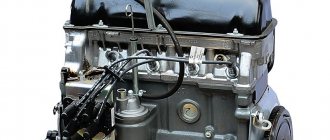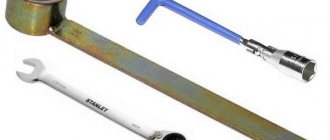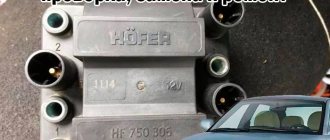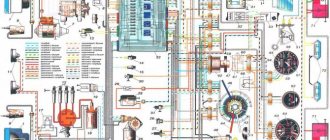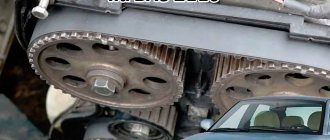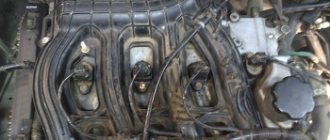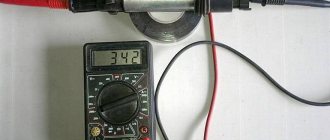In any car, the ignition system plays one of the main functions. It is thanks to its correct operation that the correct operation of the power unit is ensured both when starting it and during operation of the car. What spark plugs should be used in Gazelle cars, for what reasons can the ZMZ-406 ignition coil fail, and how to install the ignition yourself? You can find answers to these and other questions below.
Spark plugs used on cars with ZMZ-405, 406 and 409 engines
Before you go to the store to buy spark plugs (SZ) for injector engines 405, 406 or 409, you need to read the service book for the car. The manual must clearly indicate the SZ models, the operation of which is allowed in such motors. The manufacturer officially recommends using SZ A14DVR or their analogues. If you decide to give preference to analogues, then keep in mind that the spark gap in the spark plugs should be 0.7-0.85 mm.
Some motorists, leaving reviews on the Internet, recommend using the SZ A17DVRM, but this is not allowed for two reasons:
- first of all, these products have a different heat dissipation parameter;
- In addition, their gap is 1 mm, and this is not suitable for these engines.
Finding A14DVR devices today is not so easy, so many car enthusiasts have to look for analogues.
So that you can choose a similar product, we suggest that you familiarize yourself with the decoding in more detail:
- A - this beech determines the diameter, as well as the pitch of the thread D. The original SZ uses an M14 * 1.25 thread.
- 14 is the value of the heat number. It is considered one of the main parameters that determine the characteristics of the temperature regime of the product.
- D is the value of the thread length. In our case, the SZ are equipped with a thread 19 mm long.
- B - determines how much the thermal cone of the insulator protrudes into the combustion chamber of the motor itself. Thanks to the protrusion of the cone, the product warms up faster when starting the power unit, and this, in turn, ensures its higher resistance to soot formation.
- The last symbol - P - determines the presence of a built-in resistor element in the SZ design. Thanks to the presence of a resistor, the level of interference for radio equipment, as well as the motor control module, is reduced. In general, the presence or absence of this element in the design of the SZ will not in any way affect the functionality and quality of spark formation when starting the internal combustion engine.
Replacement intervals and signs of malfunction
On average, the service life of modern SZ is about 20 thousand kilometers. Of course, this indicator depends on many conditions. First of all, this is the quality of the completed part, its operating conditions, as well as the quality of the fuel used. The last point is very important, since the use of low-quality fuel will lead to a significant reduction in the service life of the SZ.
What are the signs of faulty spark plugs?
- If you remove the SZ from its seat, you will see its body. The presence of soot and deposits on the device body, in particular on the electrode, may indicate a breakdown of the product. You can try to solve such a problem by cleaning, but this does not always help.
- Presence of oil traces on the SZ. Due to oil exposure, the product cannot work efficiently, so problems may occur in the operation of the SZ. Such devices need to be cleaned and dried, but before further use it is necessary to determine the reason for the contact of motor fluid with them.
- Also, fuel traces on the devices may indicate a malfunction of the SZ.
- Another sign is that the starter has to be turned for a long time, and the engine may start after a long period of time, or may not start at all. The same symptoms indicate a dead battery, a broken distributor, or an incorrectly functioning fuel pump.
- When the engine warms up, unpleasant and uncharacteristic sounds appear. They may also appear when idling.
- Fuel consumption during vehicle operation has increased significantly.
- In addition, the volume of harmful substances in exhaust gases has increased. Of course, this malfunction cannot be determined by eye; a more thorough diagnosis is required.
- The vehicle's traction has weakened significantly, its power has decreased, and the engine has difficulty picking up speed.
Replacement frequency, signs of malfunction
The manufacturer provides for the replacement of glow plugs on 405 and 406 engines installed on Gazelle after 30-50 thousand km.
However, their performance depends on many factors - the quality of the fuel, the correct installation of the ignition, the integrity of the wiring and the absence of breakdown to the housing.
It is recommended to periodically check their condition. The color of the spark plug base may indicate some problems with the operation of the power unit systems.
With a properly installed ignition and high-quality fuel, the base should have a light brown color (popularly called “brick”, since this is the color of red fire brick).
Black color can signal either a missed spark due to a malfunction, problems with wiring or ignition failure, or a violation of mixture formation in the power system.
A clear sign of a malfunction is the formation of an orange band on the spark plug insulator near the skirt. The appearance of such a belt indicates a loss of tightness and the breakthrough of gases through it.
Checking the spark plugs yourself
According to the wiring diagram for engines 405, 406 and 409, spark plugs are used to transfer spark from the switchgear to the engine cylinders. If the operation of the SZ is disrupted, this may affect the quality of the motor as a whole.
To check devices you will need an assistant:
- You need to disconnect the high-voltage wire from the first SZ.
- Using a key, the product is unscrewed from its seat.
- One end of the device from the electrode side should be brought to the engine or metal on the car body, the distance between the electrode and the ground should be about 1-2 mm.
- The assistant then turns the starter to try to start the engine. If at the moment of cranking a spark jumps between the electrode and the body, this indicates that the product is operational. In the same way, you need to check each SZ. Please note that problems with spark supply can also be caused by improper operation of the distributor, as well as damage to high-voltage wires.
How to check short circuit?
How to check the short circuit yourself:
- First, disconnect the power cable from the negative terminal of the battery and turn off the ignition.
- Then open the hood and disconnect the two high-voltage cables from the product. Unscrew the bolts and also dismantle the bar along with the product. The second short circuit is dismantled in a similar way.
- The diagnostic procedure itself is carried out using an ohmmeter; its probes are connected instead of disconnected wires. After connecting the probes, it is necessary to measure the resistance level. If the product is operational and in good working order, then the resistance level should be about 0.4-0.5 Ohm.
- To obtain more accurate diagnostic data, you can also short-circuit the tester probes, and then perform resistance diagnostics again. In particular, you are now interested in the secondary winding of the device. If the device is operational, then the resulting value should be around 5-7 kOhm. If the diagnostics showed different values, this indicates that the short circuit needs to be replaced.
Photo gallery “Short circuit diagnostics”
Typical unit malfunctions and ways to eliminate them
A malfunction in the operation of the short circuit can occur for the following reasons:
- There is a short circuit within the system, which may cause the device to overheat. If the operating temperature exceeds 150 degrees, the product will fail irrevocably.
- The second reason is a faulty power supply from the car's electrical network. As you know, for normal operation of electrical devices, the voltage level in the on-board network must be at least 11.5 volts. If the power is too low, it will take much longer to charge the short circuit.
- The device may also fail due to mechanical damage to the insulation. This problem is usually associated with engine fluid entering through worn out seals.
- Poor contact of the product with the on-board network. If the short circuit housing is damaged, this may cause moisture to enter the primary or secondary windings, which in turn can lead to the appearance of transition resistance.
- Thermal problems. Some short circuit models are more susceptible to heat generation than others, which can also affect their service life.
- As a result of exposure to engine vibrations, the performance of the short circuit may also be impaired.
Instructions for connecting short circuit
The ZMZ 405, 406 and 409 engines use two short circuits - one of them works with cylinders 1 and 4, and the second with cylinders 2 and 3. The first of them is located closer to the intake manifold, and the second is located next to the exhaust manifold. To make the connection correctly, low voltage wires should be connected in pairs - those used for the first coil (cylinders 1-4) will be shorter in length. Since the short circuits themselves are not polar, it does not matter which contact the cable will be connected to; it also does not play a role within the pair to which cylinder the wire will be connected (the author of the video is the SpawnyXC90 channel).
Basic aspects of ignition installation
The main aspects to consider when installing the ignition by marks:
- First, you need to dismantle the front cylinder head cover; to do this, you need to unscrew four 12-point screws. In some engine modifications, dismantling also involves removing the fuel pump.
- Then the upper hydraulic tensioner located in the head is dismantled; to do this, two screws securing the cover are unscrewed.
- Next, the chain stabilizers are removed - the middle one, as well as the top one; for this, the two screws that secure them are unscrewed.
- After this, the camshaft sprockets are dismantled. The shafts themselves need to be fixed using a 27 key, while simultaneously unscrewing the screws that secure them. In modifications of engines 4063.10, the camshaft sprocket is removed along with the fuel pump drive eccentric.
- In accordance with the jig installed on the sprocket, six holes should be drilled in each of them. Their angular displacements should be 2, 30, 5, 00, 7 and 30 degrees from the set position of the factory hole, which is located along the axis of symmetry.
- If, when adjusting the phases, it is necessary to turn the camshaft clockwise, the sprocket itself should be mounted on one of the additional holes with a positive offset. It is located to the right of the standard hole.
Adjusting the fuel level in the float chamber
An incorrectly set gasoline level in the PC is an imbalance in engine operation. If it is too high, the mixture will be enriched, and one of the most noticeable consequences of this state of affairs will be increased fuel consumption. At a level below the norm, the fuel assembly will be lean, which is even worse for the engine, since it can lead to serious damage requiring expensive repairs.
Thus, the fuel level in the float valve is a critical indicator for any carburetor, regardless of the brand and model.
To accurately adjust the float in the K-151 chamber, we will need a ruler and a drill with a diameter of up to 2 mm.
we install the machine on a flat horizontal platform (this is important since we will be working with liquid); dismantle the air filter housing located on the power unit; we start the engine, let it run at XX for about 5-7 minutes; unscrew and remove the top carburetor cover; measure the fuel level in the float chamber in millimeters. This operation should be carried out promptly, since gasoline is characterized by a high volatility rate, especially in the heat, which will also be facilitated by engine heating
By delaying, we risk getting distorted results; for K-151, measurements should give about 215 millimeters - this is an indicator considered normal for efficient engine operation; if the level does not correspond to the standard level, we perform an adjustment, which consists of changing the position of the float; To do this, we need to use something that allows us to measure the position of the float during adjustment work - the drill suggested at the very beginning, or a piece of wire, or any similar cylindrical object will come in handy. The main thing is that its diameter does not exceed two millimeters; turn the K-151 cover over and place it on a flat horizontal surface - only in this position will the measurements be accurate; Using a ruler, measure the distance from the carburetor cover (choose a cardboard gasket as a reference point) to the lower edge of the float. This distance should be no more than two mm; if this is not the case, you should bend the tongue of the float lever in such a way as to achieve the standard clearance.
The same operation can be performed using a caliper, but in this case you need to measure the distance from the cardboard spacer to the top edge of the float. The correct result is 30 millimeters. If there is a discrepancy, we again bend the lever tongue, achieving the required value.
Please note that when making all the settings described above, there is a possibility of errors, especially if this is done by an inexperienced car owner. Therefore, after making the adjustment, you must check its correctness. This is done like this:
- move the K-151 cover to a vertical position;
- we monitor the tongue that we bent (or did not touch if the level was normal);
- If everything is done without errors, the tongue should lightly press and press the damping ball located on the IR. In this case, the lever tongue should be located at a level running strictly parallel to the needle valve;
- We also look at the float stamping axis, which should be located at a level coinciding with the carburetor cover.
If at least one of these conditions is not met, the procedure for adjusting the fuel level in the PC will have to be repeated. Many drivers limit themselves to two iterations, even if the situation requires otherwise. We recommend that you complete the setup properly, regardless of the time spent - the experience gained will definitely be useful to us!
From the very beginning of production, the Gazelle was equipped only with the ZMZ 402 engine, but since 1996, the ZMZ 406 engine began to be installed on the car as a series. The internal combustion engine was equipped with an electronic ignition system, but unlike the Volga, which already had an injector, the Gazelle had an injector. decided to leave the carburetor.
Engine installed on Gazelle 406
Gas candles - will there be an effect?
Installing gas equipment (LPG) reduces fuel costs, but seriously changes the operating mode of the engine. Many drivers who have installed gas equipment in their car are wondering whether they need any special spark plugs for gas, and if so, which ones? After reading the article, you will learn how and why the operating mode of the engine changes, what processes occur in the combustion chamber and how spark plugs affect them. This will help you choose spark plugs that will make the engine work better and will not reduce its service life.
Popular foreign analogues
German spark plugs “Gazelle” (405 engine) “digest” well. They are also suitable for the 406 unit. Popular brands include Bosch products with models W8D and WR8D, products from Brisk LR17Y or LR17YC. Champion also produces spark plugs for the Gazelle - models NR11Y and NR11YC. Another popular brand is NGK. This manufacturer's models BPR5E and BPR5ES are suitable for these motors.
Denso also offers two models - W16EXP and W16EXP-U.
If you need a spark plug (Gazelle 4216), then all the brands and models presented will also fit this engine. The main thing is that the model has a long thread.
What is the difference between gasoline and gas
Here are the main differences between gasoline and liquefied natural gas (LNG):
- octane number: gasoline 95–98, gas 105–115;
- boiling point: gasoline from 33 degrees, LNG minus 42 degrees;
- engine compression ratio: gasoline 9.0–10.0 gas 10.5–12.
The characteristics of gas (propane and butane) are very different from gasoline. A high octane number does not allow you to simply connect an LPG to an engine designed to work with 80 or 92 gasoline, because such fuel will quickly damage the engine. If the compression ratio is greatly mismatched with the fuel, the temperature and combustion rate of the fuel will change. In addition, the injector sprays propane more efficiently than gasoline. A high octane number requires an increase in the compression ratio to at least 10.5, otherwise the engine will overheat in high power mode.
When operating on LNG, carbon deposits do not form on valves and spark plugs, even if the compression ratio is insufficient, which is a serious advantage of gas.
There is a known case when an LPG (propane) injector was connected to a working Gazelle with a ZMZ 406 engine without even adjusting the ignition. After 40 thousand kilometers, one of the cylinder head valves burned out due to severe overheating. There is also a known case when a rebuilt carburetor ZMZ-402 under 92 (and not an injector, but a carburetor), installed on an old Volga, ran on gas for 250 thousand kilometers until the next repair. Because the driver was attentive to the preparation of the engine. I increased the compression ratio by grinding the cylinder head, set the correct ignition and installed the coldest spark plugs.
see also
Comments 45
long skirt NOT FOR VOLGA!
for contactless ignition, spark plugs and wires must have resistance
Install new ones, the old ones are not suitable for your motor, the thread length does not match
Everyone who was able to wrap long candles had no problems. Convenience high heads for 76-80 gasoline, this is because the combustion chamber is enlarged. There are high and low heads. And what kind of gasoline you pour is white for everyone.
I have 4.2 milled, got close to the thread, but the spark plugs have a long thread and cold 17, and the thread won’t come out, I was worried, I put two washers in, and when I took off the head it turned out that it was in vain.
Candles for 402 with a short skirt and for 76 also with a short skirt.
The new spark plugs are correct.
What does the length of the skirt have to do with the octane number of the fuel? I agree that if you insert a spark plug with a long skirt into a head machined for 92/95 gasoline, it can reach the piston, but one should not conclude from this that such a spark plug can and should be screwed into a cylinder head for 80 gasoline!
Never screw spark plugs with long skirts into old Volga engines - then you won’t be able to unscrew them because of carbon deposits.
Thread diameter: 14.0 mm Thread length: 12.7 mm According to potassium number Domestic Engels 17e (for 92 gasoline) Foreign analogues NGK BP7HS BOSCH W5B M 14 X 1.25 Champion UL82Y Autolite 275
For 402 or lawn go NGK BP6H. According to catalogues. They probably have different heat ratings
Perhaps, I don’t remember, I picked them up a long time ago, rummaged through the catalogs, for some reason I preferred them, maybe they are colder, I don’t remember now. I ordered the last ones from the list from the states, by the way, the standard candles are with a black coating, kind of like besfolitation.
For 402 or lawn go NGK BP6H. According to catalogues. They probably have different heat ratings
On 402 and lawn there are A14 spark plugs, their analogue from NGK is BP5. BP6 - analogue of A17
Judging by the photo, a spark plug with a long thread does not match the engine... the presence of carbon deposits on the thread indicates that the spark plug is leaking into the combustion chamber, and this is bad and even unacceptable, only short spark plugs should be installed on 402m!
Well, from the photo you can see that the candle is sticking out and covered with soot...
There is a clear discrepancy between the head and the candles, it didn’t take long to catch a fist in the head
I have 4 76 heads, they are also short. There is a difference in candles. under 76 A11, under 92 A14
I can take a picture right now. Short
Both long and short ones go with the 76 head. I rode the long ones with the 76 head on the 92 lutz until I switched to engineer
Only short ones fit any 402 head. the fact that you wrapped the long ones is your personal initiative not supported by anything.
What's the difference between 76 and 92? the threads are the same. In general, everything is the same, only the plane of which is adjacent to the block above.
There are no deep threads on such motors. Unless in the new 4216
Judging by the photo, a spark plug with a long thread does not match the engine... the presence of carbon deposits on the thread indicates that the spark plug is leaking into the combustion chamber, and this is bad and even unacceptable, only short spark plugs should be installed on 402m!
Thank you. So, I put short ones with peace of mind.
There should not be long 402s. Not only is there a risk of not being able to unscrew them at all. So they will also be the source of detonation.
There should not be long 402s. Not only is there a risk of not being able to unscrew them at all. So they will also be the source of detonation.
Elementary. Any sharp corner in the combustion chamber is a place of local overheating. A candle is no exception. The more the spark plug thread sticks out into the combustion chamber, the worse it is. It is due to the edge that self-ignition can occur. If you don’t unscrew it, the thread becomes clogged with carbon deposits. This is described in Soviet operating books.
Do you need special spark plugs for LNG?
Many motorists come to the store with a request - I need special gas spark plugs for the injector and do not understand that no one produces such products. Candles are divided not by brand or type of fuel, but by heat rating. If you have a 98 gasoline engine, no carbon deposits form on the valves, compression is normal, and you drive without extreme loads, then you do not need any special spark plugs. It is enough to use the coldest ones recommended in the manual. If you use medium spark plugs (heat number from 11 to 17), then you need to check them once every 2-3 months, but no later than after 10 thousand kilometers. It is necessary to check whether carbon deposits have appeared and whether the gap corresponds to the specified value. This will help determine if they are suitable for the engine and driving conditions, or if you need to use cooler plugs.
Materials for production
In more affordable products, the electrodes are made of copper or yttrium alloys. For all their advantages and price, these parts are poorly resistant to high temperatures and are not resistant to fading.
More expensive candles are made of platinum. Both central and side electrodes are made from such alloys. This metal has very high resistance to corrosion processes. They have significantly higher reliability and efficiency indicators.
Also, in addition to materials, when choosing, a parameter such as heat rating is very important. There are cold and hot parts. What it is? This is a standard characteristic by which the time it takes for a part to reach glow ignition is judged. The higher the number, the less the element will heat up.
spark plugs ZMZ 406
The topic of the article is ZMZ 406 spark plugs. This article was prompted to be written by the confusion that is going on on this issue. For engines ZMZ 406, 405, 409, there are two sizes of spark plugs. For a large spark plug wrench (21mm) and a small one (16mm). But very often people simply don’t know what the standard size is. This issue needs to be clarified somehow. I propose the following classification - old-style candles (thick) and new-style (thin).
Spark plugs ZMZ 406, identification
Since our people have almost stopped repairing cars themselves, the question of what kind of spark plugs you have in your engine confuses people. I’m not at all against the fact that everyone should mind their own business, but sometimes you need to know simple things in order to correctly order or buy consumables. I thought for a very long time about how to simply identify which candles are worth. The engine model says absolutely nothing. I myself did not know that the first releases of ZMZ 409 had “thick” spark plugs, I was sure that there could only be “thin” ones. People also cannot always answer the question of Euro-2, E-3 or E-4. Identification by ignition coils turned out to be the simplest and most understandable. If there are two coils on the valve cover - high-voltage wires and old-style spark plugs, if the coils are individual - new-style spark plugs. This is where it’s hard to miss.
General technical specifications
As mentioned above, on the 406 engine the factory installs a perfect carburetor or injector. It is four-cylinder, has an electronic ignition system, as well as control electronics, which allows you to adjust the carburetor or injector to the operating conditions of the car.
These engines also have a special oil cooler installed, which is designed to cool the lubricant, but experts and car enthusiasts agree that this is an extra unit, since when operating such power units, they practically do not overheat. The exhaust and fuel systems, muffler, depending on the modification, comply with Euro 2 standards, as well as other environmental requirements. The cylinders are arranged in-line. The power of this engine depends not only on its modification, but also on the load that goes to the power unit and is regulated electronically.
Specifics
Still, most of the engines that have “old-style” spark plugs are ZMZ 406. And most of them are found in Volga, Sable and Gazelle cars. My work experience has shown the following trend. Or owners of similar cars need a budget option or one of the best. There is no average. Therefore, to complete the orders, I chose “regular” Bosch candles and Denso candles from the Nickel TT line. I won’t even consider our candles and all sorts of different Brisks, the reason is written in the article about “new sample” candles.
Description
IGNITION COIL
Manufacturer: SOATE
Designation: 406.3705
PURPOSE
For operation as part of microprocessor control systems in UAZ vehicles (engine 406, 409 inzh.), GAZ (equipped with engines of the ZMZ-406 type and their modifications), OKA.
SPECIFICATIONS
The operating mode of the ignition coil…………………………………….long.
Operating temperature range, °C……………………………………..-40…+120
Relative air humidity……………………………………95% at a temperature of +40C
Rated supply voltage, V……………………………..12
Vehicle network voltage………………………………………………………from 6 to 18 V.
Weight, no more, kg………………………………………………………..0.51
Overall dimensions………………………………………………………..81x80x67
Coil 406.3705 GAZ, UAZ, OKA (engine 406, 409 ing.) 2 connectors, IGNITION MODULE “SOATE” ** / 406.3705000-10
- article 406.3705000-10;
- in stock and available for purchase;
- price as of 05.29.21 - 702 rubles;
- Delivery is carried out throughout Russia.
Place your order for this product online right now!
You must be logged in to the site to leave a question about a product.
no messages for this product
Spark plugs ZMZ 406, Bosch
Consumables of this type are what I call “an honest workhorse.” There are not enough stars from the sky, but it performs its function well from replacement to replacement. And one more thing I’ve always liked about Bosch candles is differentiated pricing. Let me explain. There are several lines of candles: regular, platinum, multi-contact, etc. There is a gradation in price between candles of different classes. Bosch always tries to make a simple line of candles very affordable. This is not always the case in stores, but let it remain on the conscience of the sellers. In this case I am talking about the general approach. These spark plugs are listed in the catalog specifically for these engines. Replacement interval, either together with an oil change, or according to condition. But be sure to measure the distance between the electrodes. The manufacturer's recommended gap is 0.8-0.9 mm.
Spark plugs ZMZ 406, Denso
In 2010, the Japanese manufacturer Denso patented and began producing spark plugs using TT (Twin Tip) technology. The essence of the technology is thin electrodes that do not contain rare earth metals (platinum, iridium). The central electrode is made of nickel. But thanks to its design, the flammability of the mixture and other parameters are very close to the “platinum-iridium line” candles from other manufacturers, while remaining humane in price. From my experience, I note a good launch in the cold season. Candles come in a set of 4 pieces. Below are photos of the spark plug electrodes. These spark plugs have a longer replacement interval than a simple ruler, but they also do not last forever. The calculated interval recommended by the manufacturer is 30-40 thousand km. In Russian conditions and our gasoline is not the best, I recommend changing these spark plugs after 15 thousand km, that is, approximately once every two oil changes.
line of Nickel TT spark plugs, electrodes
Design
These parts can come from a wide variety of manufacturers and may have different designs. Candles also differ in materials. By design, these elements are divided into two-electrode and multi-electrode.
So, in a part that is equipped with two electrodes - one central and one side electrode.
In the second case there are more than one side ones. A larger number of electrodes allows for higher reliability, durability and efficiency. All this will affect the service life.
Unlike a multi-electrode solution, a classic product has only one electrode, which burns out or breaks during operation. In this case, only replacing the spark plug will help. The Gazelle, which has a multi-electrode element, is more resistant to temperatures.

